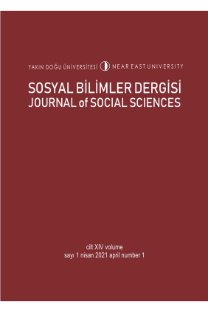Japonya'nın 3/11 öncesi ve sonrası enerji politikası: Sıkıntı veren dersler ve bulanık olasılıklar
Japan's pre and post 3/11 energy policy: Distressing lessons and blurred prospects
___
- "Eastern Japan Paralyzed by Unprecedented Earthquake". Japan Energy Brief. IEEJ. No. 12. March 2011. Retrieved from: http://eneken.ieei. or.jp/en/jeb/ 1103.pdf
- "Energy News in Japan and Asia". Japan Energy Brief IEEJ. No. 13, May, 2011. From "Unplanned Power Outages" towards a "Strategic Energy Shift". A Report on Japan's Energy Shift since March 11th. Institute for Sustainable Energy Policies, Japan. May 6, 2011, p. 22. Retrieved from http://www.isep.or.ip/images/ press/ISEP Strategy%20Nol%20Revised.pdf
- Fukao, Mitsuhiro (2011). "The Great East Japan Earthquake and Japan's Financial Consolidation". Japan Economic Currents. A Commentary on Economic and Business Trends. Keizai Koho Center. Retrieved from: http://www.kkc.or.jp/ english/activities/publications/economic-currents79.pdf
- "Higashi Nihon Shinsai ni okeru Higaigaku no Suikei ni tsuite [Information on Estimates of the Damages Caused by the Great East Japan Earthquake]". Retrieved from: http://www.bousai.go.ip/oshirase/h23/110624-lkisva.pdf
- IAEA mission to review NISA's approach to the "Comprehensive assessments for the safety of existing power reactor facilities" preliminary summary. Tokyo and Ohi, Japan. 23-31 January 2012. Retrieved from: http://www.iaea.org/newscenter/ focus/fukushima/prereport310112.pdf
- Ishibashi Katsuhiko (2007). "Why Worry? Japan's Nuclear Plants at Grave Risk from Quake Damage". The Asia-Pacific Journal: Japan Focus. August 11.
- Japan Energy Brief No. 17. January 2012. Retrieved from: http://eneken.ieei.or. ip/en/i eb/1201 .pdf
- "Japan Rode over Summer with Nationwide Power Saving". Japan Energy Brief. IEEJ. No. 15, September 2011. Retrieved from: http://eneken.ieei .or.jp/en/ jebZ1109.pdf
- Japanese town's dependence on nuclear plant hushes criticism. Asahi Shimbun. January 27, 2012. Retrieved from: http://aiw.asahi.com/article/behind news /social affairs/AJ201201270014
- Johnson, Chalmers (1982). MITI and Japanese Miracle: The Growth of Industrial Policy. Stanford: Stanford University Press.
- Kaneko, Shuichi (2012). "Nuclear Safety Regulation Reform in Japan". Retrieved from: http://www.oecd-nea.org/nsd/fukushima/documents/workshQp Japan Task ForcePresentation.pdf
- Kono, Ryutaro (2011). "Future Economic Scenarios for Quake-Hit Japan". Japan Economic Currents. A Commentary on Economic and Business Trends. Keizai Koho Center. Retrieved from: http://www.kkc.or.ip/english/activities/ publications/economic-currents78.pdf
- Maeda, Risa (2012). "Insight: Japan's Nuclear Crisis Goes Much Further than Fukushima". Reuters. February 23. Retrieved from: http://www.reuters.com/ article/2012/02/24/us-i apan-nuclear-waste-idUSTRE81N08P20120224
- Son, Masayoshi (2011). Presentation at the JREF launch. Retrieved from: http://iref.or.ip/images/pdf/20110912 presentation e.pdf
- Minoura, Koji and Nakaya, Shuyu (1991). "Traces of Tsunami Preserved in Inter-tidal Lacustrine and Marsh Deposits: Some examples from Northeast Japan". Journal of Geology. Vol. 99. No. 2 Retrieved from: http.V/www.jstor.org/ pss/30081120
- Morita, Yuji (2011). "Japan's Issues and Concerns on Energy Supply and Demand after the Great East Japan Earthquake". The Institute of Energy Economics, Japan (IEEJ). Retrieved from: http://www.pecj.or.jp/iapanese/ overseas/conference/pdf/conference08-07.pdf
- "Nuclear Crisis: How it Happened. 'Nuclear Power Village' A Cozy, Closed Community. Yomiuri Shimbun. June 16, 2011. Retrieved from: http://www.vomiuri.co.ip/dv/national/T110615Q05652.htm
- "Nuclear Power in Japan". World Nuclear Organization. Retrieved from: http://www. world-nuclear. org/info/inf7 9 .html
- Oshima, Kenichi (2010). Political Economics of Recyclable Energy, Toyo Keizai Inc.
- Pickett, Susan E. (2002). "Japan's Nuclear Energy Policy: From Firm Commitment to Difficult Dilemma Addressing Growing Stocks of Plutonium, Program Delays, Domestic Opposition and International Pressure". Energy Policy. 30: 1337-1355.
- Pritchard, Justin (2011). Realistic Safety Debate Not Nuke Sector, Regulator Forte. The Japan Times. May 5, 2011. Retrieved from: http://www. japantimes.co.ip/text/nn20110505fl .html
- Report on Cost Verification by the Cost Verification Committee of the Energy and Environment Council [Kosuto-tö kenshö iin kaihökokusho. Enerugî kankyö kaigi. Kosuto-tö kenshö iinkai] December 19, 2011. Retrieved from: http://www.aec. go.ip/iicst/NC/tvoki/sakutei/sirvo/sakutei 10/sirvo2-2-3 .pdf
- Samuels, Richard J. (1987). The Business of Japanese State: Energy Markets in Comparative and Historical Perspectives. Ithaca, NY: Cornel University Press.
- Schneider, Mycle, Froggatt, Antony and Thomas, Steve (2011). Nuclear Power in a Post-Fukushima World. 25 Years after the Chernobyl Accident. Worldwatch Institute. Mycle Schneider Consulting. Retrieved from: http://download. www.arte.tv/permanent/ul/tchernobvl/report2011 .pdf
- Strategy for Rebirth of Japan. National Policy Unit. December 24, 2011. Retrieved from: http://www.npu.go.ip/policv/pdf/20120127/20120127 enl .pdf
- Takase, Kae and Suzuki, Tatsujiro (2011). "The Japanese Energy Sector: Current Situation and Future Paths". Energy Policy. 39: 6731-6744.
- The Advanced Energy Revolution. A Sustainable Energy Outlook for Japan. European Renewable Energy Council. 2011. Retrieved from: http://www.greenpeace.org/japan/Global/iapan/pdf/er report.pdf
- The Basic Energy Plan. June 2010. [Enerugi Kihon Keikaku] Retrieved from: http://www.meti.go.ip/committee/summarv/0004657/energy.pdf
- The Mainichi Daily News. February 10, 2012. Retrieved from.: http://roçhı_ mainichi.jp/mdnnews/news/2Q 120210p2g00m0dm024000c.html
- Toyoda, Masakazu (2011). "Energy Policy Agenda after the Great Japan Earthquake". The Institute of Energy Economics, Japan (IEEJ). Retrieved from: http://eneken.ieei.or.jp/data/3897.pdf
- Waldenberger, Franz (2011). "The Japanese Economy after the Tohoku Earthquake". ISPI Analysis. Retrieved from: http://www.ispionline.it/i_t/ documents/Analysis 82 2011 .pdf
- White Paper on Energy [Enerugii hakusho]. 2011. MET! Retrieved from: http://www.enecho.meti.go.ip/topics/hakusho/2011/index.htm
- White Paper on Nuclear Energy. 2009. Japan Atomic Energy Commission [Genshiryoku Hakusho. Genshiryoku iinkai . 2009] Retrieved from: http://www. aec.go.ip/jicst/NC/about/hakusho/hakusho2009/index.htm
- Yuji Matsuo, Yu Nagatomi and Tomoko Murakami (2011). "Thermal and Nuclear Generations Cost Estimates Using Corporate Financial Statements". Institute of Energy Economics, Japan. October. Retrieved from: http://eneken.ieei .or.jpI dataZ4103.pdf
- ISSN: 1986-1303
- Yayın Aralığı: Yılda 2 Sayı
- Başlangıç: 2008
- Yayıncı: Yakın Doğu Üniversitesi
Japonya'nın 3/11 öncesi ve sonrası enerji politikası: Sıkıntı veren dersler ve bulanık olasılıklar
Poulantzas'ın kapitalist devlet kuramı: Sivil toplum ve devlet arasındaki ikiliğin aşılması
Etnîk çatışmalarda siyîl toplum örgütleri ve bakışa yönelik katkıları
Osmanlı imparatorluğu'nun balkanlar'dakî kültürel ye demografik mîrasi
Japonya'nın 3/11 öncesi ve sonrası enerji politikası: Sıkıntı veren dersler ve bulanık olasılıklar
Hakikatin hakikilik kriterleri zaman düzleminde: Retrospektif yaklaşımlarda 'kısır döngü' sendiromu
KENT(Lİ)LEŞME PRATİĞİNDE YENİ BİR OLGU: TAZİYE EVLERİ ve FARKLILAŞAN sosyo-kültürel PRATİKLER
SUVAT PARİN, Emre Ahmet BİLGİLİ, Zekeriya MENAK
Poulantzas'ın kapitalist devlet kuramı: Sivil toplum ve devlet arasındaki ikiliğin aşılması
